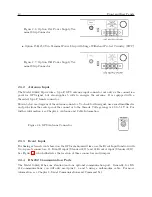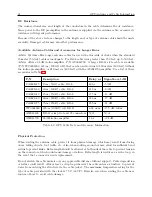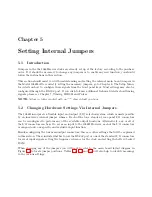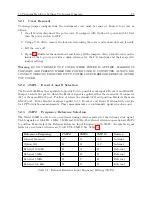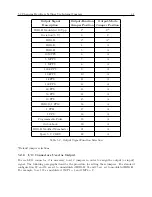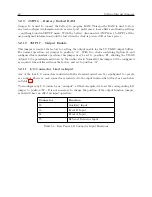
22
GPS Antenna and Cable Information
4.2
Verifying Antenna and Cable Operation
A two-color operate LED, located at the base of the antenna, indicates proper antenna operation.
GREEN indicates proper operation (i.e. the antenna is getting the correct voltage); AMBER
indicates improper operation (i.e. the voltage is low).
4.2.1
Checking the Antenna Voltage
The GPS clock pr5 Vdc to the GPS antenna, which is carried through the antenna cable.
Nominal antenna current is 13 mA (old style antennas are approximately 20 mA). Check the voltage
at the antenna connector on the rear panel. Without the signal, the antenna and the GPS clock
will not synchronize with the Global Positioning System and can generate an out-of-lock alarm, if
the Out-of-Lock feature is enabled.
4.2.2
Power Supply Check
The Antenna Voltage test (above) actually tests the main power supply voltage for all models of
clocks. This signal should be between 4.9 and 5.1 Vdc.
4.2.3
Checking the Antenna Resistance
Checking the internal resistance of the Arbiter GPS antenna is not as useful as verifying the antenna
operation mentioned above. Antenna resistance measures several megohms with meter probes at
one polarity and less so if you change the meter probe polarity (older style antennas can measure
3.8 kohms or 270 ohms).
4.3
GPS Surge Arrester
Figure 4.4 illustrates the GPS surge arrester kit (P/N AS0094500), which is mounted in line with
the antenna cable. The surge suppressor has two female F connectors, which are bidirectional, and
two ground lugs with hardware for connecting to a solid ground.
Figure 4.4: GPS Surge Arrester
Antenna
Receiver
Surge Arrester/Grounding Block
AS0094500A
4.3.1
Using the GPS Surge Arrester
Before installation, review the documentation on this device found in Appendix B. The AS0094500
surge arrester is weatherproof except for the F connectors, which may be sealed with rubber port
seals or GE Silicone II compound.
Summary of Contents for 1088A
Page 4: ...iv ...
Page 6: ...vi ...
Page 18: ...xviii LIST OF FIGURES ...
Page 23: ...1 4 Attaching Rack Mount Ears to 1088A B Series Clocks 3 Figure 1 2 Attaching Rack Mount Ears ...
Page 24: ...4 Unpacking the Clock ...
Page 32: ...12 Front and Rear Panels ...
Page 38: ...18 Connecting Inlet Power Input and Output Signals ...
Page 46: ...26 GPS Antenna and Cable Information ...
Page 48: ...28 Setting Internal Jumpers Figure 5 1 Model 1088B Main Board ...
Page 76: ...56 The Setup Menus ...
Page 112: ...92 Serial Communication and Command Set ...
Page 127: ...B 4 Physical Dimensions 107 Figure B 1 Suggested Mounting of the AS0094500 Surge Arrester ...
Page 128: ...108 Using Surge Arresters ...
Page 145: ...C 5 Option 04 Parallel BCD Output 125 Figure C 4 Option 04 Output Jumper Settings ...
Page 146: ...126 Options List Figure C 5 Option 04 Board Layout and Jumper Locations ...
Page 166: ...146 Options List Figure C 12 Option 17 Board Layout and Jumper Locations ...
Page 187: ...C 16 Option 20A Four Fiber Optic Outputs 167 Figure C 22 Option 20A Jumper Locations ...
Page 194: ...174 Options List Figure C 24 Option 23 Internal Jumper Setup ...
Page 196: ...176 Options List Figure C 25 Option 27 Jumper Locations ...
Page 214: ...194 Options List Figure C 28 Option 29 Connector Signal Locations ...
Page 270: ...250 Options List ...



